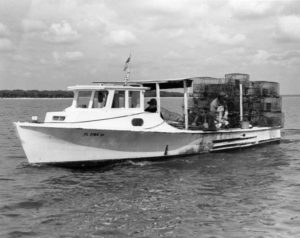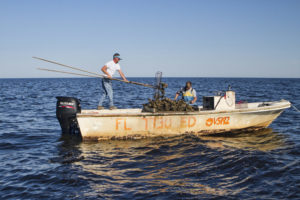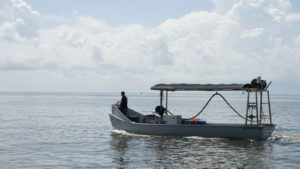Shellfish live and grow in unique habitats. The boats fishers use to harvest them are as unique and interesting as the shellfish themselves.

Crabbing
Equipped with plenty of deck space to carry bulky crab traps, crabbing boats are hard to miss. Blue crabbing vessels are typically flatter on the bottom. This allows crabbers to access shallow waters and muddy bottoms where blue crabs grow. Stone crabbing vessels tend to be larger and more capable of handling the rougher conditions farther offshore, where stone crabs thrive in hardbottom habitats. Some crabbing boats, especially stone crab boats, are equipped with a motorized pulley system used for hauling in heavy traps. But many blue crabbers still pull traps by hand.
Other than the invention of the crab trap in the 1920s and advances in motorized and electronic equipment, crabbing and crabbing vessels have not changed much with time. Prior to the widespread availability of crab traps, blue crabs were caught using baited lines held on the bottom by lead weights. Fishers would pull up the baited lines and use a hand net to capture blue crabs clinging to the bait.

Shrimping
Deep-keeled and large shrimping vessels are able to travel long distances offshore. Long beams called outriggers are lowered to help stabilize the vessel. They also support hefty nets and wooden or metal “doors” that keep the nets open while they are towed. Shallow draft boats work inshore waters and use roller frames to tow nets along the rocky and grassy sea bottom. Other than the addition of mandatory turtle excluder and bycatch reduction devices, the boats, nets, and other equipment used to harvest shrimp has changed little since the inception of the commercial shrimping industry.

Oystering
Oyster boats are designed to access shallow, inshore waters where oysters thrive. Oystering vessels are equipped with a sorting or “culling” board harvesters use to sort market size oysters. These vessels also have open decks with wide walking planks around the sides to allow tongers to access the water from anywhere on the boat.
Clam Farming
Large skiffs and “bird dog” boats are the workhorses of the local aquaculture industry. A father and son team, who built fishing boats, modified their “bird dog” design for use in the new clamming industry in the 1990s. Named after them (Lisenby), this fiberglass boat maintains some of the key features of a bird dog but incorporates a wider beam, higher and open deck, and small keels.
The term “bird dog boat” comes from the fact that the motor is placed in the front of the boat, pointing where it is going-much like a bird dog. With the motor out of the way, workers have easy access to the water. The captain, perched in front, can better navigate in the shallow waters of the Big Bend.

Bird dog boats have a low transom that allows workers to easily access the deck from the water. The shade screen or roof over the top of the boat helps keep workers and shellfish cool in the hot Florida sun. The large hose on the side of many boats helps clear sand and mud from the clams to reduce the weight that the boat and workers must transport.
The average clam boat can haul 40-60 bushel baskets of 1,500 clams each. That’s up to 50,000 clams…Yum! Brightly colored bushel baskets are used to transport market-sized clams to the wholesaler. Seed-sized clams from the hatchery are planted in mesh bags, rolled up on the deck of the boat for easier transport.